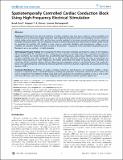| dc.contributor.author | Dura, Burak | |
| dc.contributor.author | Kovacs, Gregory T. A. | |
| dc.contributor.author | Giovangrandi, Laurent | |
| dc.date.accessioned | 2012-07-20T18:14:49Z | |
| dc.date.available | 2012-07-20T18:14:49Z | |
| dc.date.issued | 2012-04 | |
| dc.date.submitted | 2011-11 | |
| dc.identifier.issn | 1932-6203 | |
| dc.identifier.uri | http://hdl.handle.net/1721.1/71734 | |
| dc.description.abstract | Background:
Methods for the electrical inhibition of cardiac excitation have long been sought to control excitability and conduction, but to date remain largely impractical. High-amplitude alternating current (AC) stimulation has been known to extend cardiac action potentials (APs), and has been recently exploited to terminate reentrant arrhythmias by producing reversible conduction blocks. Yet, low-amplitude currents at similar frequencies have been shown to entrain cardiac tissues by generation of repetitive APs, leading in some cases to ventricular fibrillation and hemodynamic collapse in vivo. Therefore, an inhibition method that does not lead to entrainment – irrespective of the stimulation amplitude (bound to fluctuate in an in vivo setting) – is highly desirable.
Methodology/Principal Findings:
We investigated the effects of broader amplitude and frequency ranges on the inhibitory effects of extracellular AC stimulation on HL-1 cardiomyocytes cultured on microelectrode arrays, using both sinusoidal and square waveforms. Our results indicate that, at sufficiently high frequencies, cardiac tissue exhibits a binary response to stimulus amplitude with either prolonged APs or no effect, thereby effectively avoiding the risks of entrainment by repetitive firing observed at lower frequencies. We further demonstrate the ability to precisely define reversible local conduction blocks in beating cultures without influencing the propagation activity in non-blocked areas. The conduction blocks were spatiotemporally controlled by electrode geometry and stimuli duration, respectively, and sustainable for long durations (300 s).
Conclusion/Significance:
Inhibition of cardiac excitation induced by high-frequency AC stimulation exhibits a binary response to amplitude above a threshold frequency, enabling the generation of reversible conduction blocks without the risks of entrainment. This inhibition method could yield novel approaches for arrhythmia modeling in vitro, as well as safer and more efficacious tools for in vivo cardiac mapping and radio-frequency ablation guidance applications. | en_US |
| dc.language.iso | en_US | |
| dc.publisher | Public Library of Science | en_US |
| dc.relation.isversionof | http://dx.doi.org/10.1371/journal.pone.0036217 | en_US |
| dc.rights | Creative Commons Attribution | en_US |
| dc.rights.uri | http://creativecommons.org/licenses/by/2.5/ | en_US |
| dc.source | PLoS | en_US |
| dc.title | Spatiotemporally Controlled Cardiac Conduction Block Using High-Frequency Electrical Stimulation | en_US |
| dc.type | Article | en_US |
| dc.identifier.citation | Dura, Burak, Gregory T. A. Kovacs, and Laurent Giovangrandi. “Spatiotemporally Controlled Cardiac Conduction Block Using High-Frequency Electrical Stimulation.” Ed. Vladimir E. Bondarenko. PLoS ONE 7.4 (2012): e36217. | en_US |
| dc.contributor.department | Massachusetts Institute of Technology. Department of Electrical Engineering and Computer Science | en_US |
| dc.contributor.approver | Dura, Burak | |
| dc.contributor.mitauthor | Dura, Burak | |
| dc.relation.journal | PLoS ONE | en_US |
| dc.eprint.version | Final published version | en_US |
| dc.type.uri | http://purl.org/eprint/type/JournalArticle | en_US |
| eprint.status | http://purl.org/eprint/status/PeerReviewed | en_US |
| dspace.orderedauthors | Dura, Burak; Kovacs, Gregory T. A.; Giovangrandi, Laurent | en |
| dc.identifier.orcid | https://orcid.org/0000-0001-6449-8889 | |
| mit.license | PUBLISHER_POLICY | en_US |
| mit.metadata.status | Complete | |
